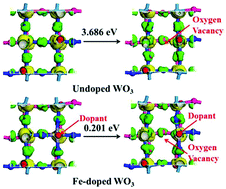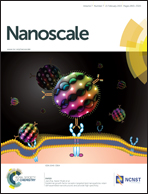Iron-doping-enhanced photoelectrochemical water splitting performance of nanostructured WO3: a combined experimental and theoretical study†
Abstract
In this paper, we have studied Fe-doping of nanostructured tungsten trioxide (WO3) and its pronounced effect in promoting the photoelectrochemical (PEC) water splitting performance. Vertically aligned Fe-doped WO3 nanoflakes on fluorine-doped tin oxide (FTO) were synthesized via the hydrothermal method. An X-ray photoelectron spectroscopy (XPS) analysis confirmed the Fe3+ substitution at the W6+ site in the prepared films. Broadened visible light absorption was observed in doped films, likely due to the formation of extra band states through doping. The Fe-doping was shown to greatly improve the PEC water splitting performance of WO3. More specifically, the 2 mol% Fe-doped WO3 achieved a photocurrent density of 0.88 mA cm−2 at 1.23 V versus RHE, approximately 30% higher than that of the undoped WO3 (0.69 mA cm−2 at 1.23 V versus RHE). This enhancement was attributed to the reduced band gap and the doping-enhanced charge carrier density as confirmed by the absorption spectra and the Mott–Schottky plots, respectively. Finally, first-principles density functional theory (DFT) calculations confirmed that the formation of oxygen vacancies was favored after Fe-doping, contributing to the increased charge carrier density in slightly doped films.


 Please wait while we load your content...
Please wait while we load your content...